WORD NEWS
Inside huge beef’s local weather messaging machine: confuse, defend and downplay | Beef
The US beef {industry} is creating a military of influencers and citizen activists to assist amplify a message that might be key to its future success: that you simply shouldn’t be too anxious in regards to the rising consideration across the environmental impacts of its manufacturing.
Particularly, it will such as you to not be particularly involved about how meat consumption must be decreased if we’re to keep away from essentially the most violently disruptive types of planetary heating (even when all fossil gas use ended tomorrow).
It positively doesn’t need you to learn scientific papers exhibiting rich nations should scale back meat consumption to maintain beneath the common international temperature rise of 2C, a threshold to cease programs collapse, mass extinctions, deadly warmth waves, drought and famine, water shortages and flooded cities.
I find out about these {industry} priorities as I’m certainly one of greater than 21,000 graduates of a free, by-admission-only, on-line coaching course created by the US beef {industry} known as the Masters of Beef Advocacy (MBA) program.
The course is the creation of the Nationwide Cattlemen’s Beef Affiliation (NCBA), the meat {industry}’s predominant foyer group, and on after finishing it I can let you know that you simply don’t truly get a grasp’s diploma, regardless of its title.
What you get is a number of deceptive – however scientific sounding – narratives about beef {industry} sustainability and repeated appeals for college students to have interaction proactively with customers on-line and offline about environmental subjects. By way of a non-public Fb group for graduates, the NCBA additionally distributes infographics and {industry} speaking factors to deploy in on-line conversations.
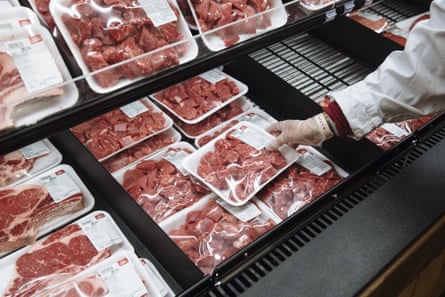
MBA-trained “advocates and spokespeople assist educate customers and influencers in regards to the position of beef in a nutritious diet and the way beef farmers and ranchers elevate beef responsibly and sustainably”, in line with one doc the Guardian has seen from the Cattleman’s Beef Board, which earmarked $572,700 for the initiative for 2023.
The Cattleman’s Beef Board is the group that oversees the federally-enshrined beef checkoff program, which funds {industry} advertising and promotion by way of a payment ranchers pay on each head of cattle.
“These advocates additionally assist to reply when there’s misinformation within the public about beef manufacturing and different beef-related points,” the doc says about graduates of the MBA programs.
My curiosity in doing the course was to higher perceive cattle {industry} messaging at a time when beef’s outsized position in local weather disaster is beneath scrutiny. My expertise as an MBA pupil, along with different particulars I uncovered as I reported this story, led me to conclude that the meat {industry} is engaged in an all-out public relations struggle to pre-empt environmental criticisms of its merchandise – and that these PR efforts are growing.
These new particulars complement the image supplied by the scientists, meals programs researchers, behavioral consultants and coverage specialists interviewed for this story, who say the {industry} is working to sow confusion in regards to the impacts of animal agriculture – sapping the desire for broader political change.
That’s to not say that every one beef manufacturing is inherently unsustainable. In the correct ecological context, and with the correct administration practices, cattle will help keep soil well being whereas yielding nutrient-dense edible protein in return, amongst different advantages. However the reality is that we already eat an excessive amount of beef for the planet’s good. The world can’t afford the rise in international beef consumption that consultants predict – whereas wealthier nations, whose residents have essentially the most emissions-intensive diets, might make speedy local weather positive factors by selecting to eat much less.
This narrative is one which industry-aligned pursuits badly need to extinguish. Via weblog posts, movies, instructional property, op-eds, TV adverts, social media campaigns, educated influencers and different channels – many described right here for the primary time – the {industry} is making an attempt to persuade us all of what the science positively doesn’t present: that dietary change has no position in local weather technique.
The Cattlemen’s Beef Board and the Nationwide Cattlemen’s Beef Affiliation, which says the US produces the world’s most sustainable beef, didn’t reply to a number of requests for remark.
Probably the most emissions-intensive meals
Based on a landmark research within the peer-reviewed journal Science, each kilogram of beef consumed provides a whopping 99.5 kgs of CO2 equal greenhouse gasses to the setting, on common. It was essentially the most climate-damaging meals studied, and the competitors wasn’t even shut. Based on a subsequent evaluation of the outcomes by researchers at Oxford College’s Our World In Knowledge challenge, beef consumption is 2.5 occasions – 250% – worse for the local weather than the runner up, sheep and lamb. Consuming beef places greater than 4 occasions extra pressure on the ambiance than consuming cheese. It’s greater than seven occasions worse than farmed fish, eight occasions worse than pork, and 10 occasions worse than poultry. It’s 21 occasions worse than eggs.
When in comparison with fruits, greens, grains and legumes, the impacts of beef consumption are even worse. The Science research discovered that, on common, producing a kilogram of beef contributed over 22 occasions extra to local weather disaster than producing a kilogram of rice and 63 occasions greater than a kilogram of wheat. Root veggies, sure tree fruits and nuts have been all greater than 200 occasions extra climate-efficient by weight than beef.
What makes beef such an outlier? Cows primarily chew for a dwelling – masticating and regurgitating grasses all day lengthy in order that powerful plant fibers can cross by way of their a number of stomachs. This course of, known as enteric fermentation, permits ruminants to nourish themselves – and due to this fact us – on vegetation few different animals might eat. However all that chomping comes with loads of reflux and belching and each burp emits a bit of methane, a planet-warming fuel 28 occasions extra highly effective than carbon dioxide over 100 years. (It’s a typical false impression that cow farts are what trigger warming; from a local weather perspective, the burps are what matter.)
As well as, the common steer consumes a number of metric tons of forage and feed in its life, which implies they want a number of room to roam. However there’s not sufficient native grasslands on earth to feed all of the cows that people need to eat. So elevating cattle usually means reducing down forests or displacing different ecosystems to make room for bovines and their meals. Taken collectively, these traits – belching, methane and grazing – add as much as a local weather triple-whammy.
In 2006, the Meals and Agriculture Group of the United Nations (FAO) printed Livestock’s Lengthy Shadow, a report that exposed animal agriculture’s vital position within the local weather disaster. By exhibiting that livestock manufacturing makes up a big proportion of worldwide emissions – round 18%, although it will later revise that quantity downward barely – in addition to contributing to different environmental points together with land degradation and water air pollution, the report generated headlines and began conversations, serving to to make the toll of meat-overconsumption front-page information.
It was additionally a second that terrified the meat {industry}. Based on Jennifer Jacquet, affiliate professor within the division of environmental research at New York College, Livestock’s Lengthy Shadow helped to encourage meat multinationals and their allies to launch a counteroffensive, working time beyond regulation to defend the environmental fame of meat, particularly beef.
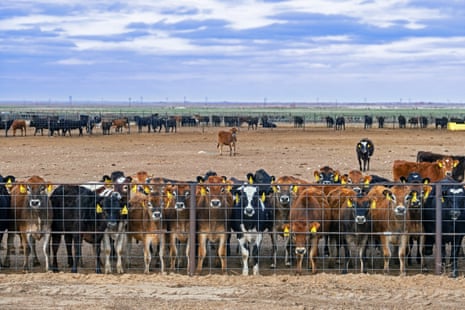
“Since no less than 2006 … the {industry} has been borrowing ways from the fossil gas playbook,” Jacquet wrote in a 2021 Washington Publish op-ed. “Whereas meat and dairy producers haven’t claimed that local weather change is a liberal hoax, as oil and fuel producers did beginning within the Nineteen Nineties, corporations have been downplaying the {industry}’s environmental footprint and undermining local weather coverage.”
Of the main meat lobbies, the meat {industry} has arguably performed essentially the most to mobilize on the subject of local weather. The Guardian’s evaluation of technique and funding paperwork from the previous decade reveals that the cattle enterprise sees itself as perpetually beneath assault by a wide range of hostile forces – with environmental points of accelerating concern.
“The meat {industry} seemingly is beneath steady assault on a number of fronts,” in line with a 2022 technique doc from the Cattlemen’ Beef Board. “These assaults regularly are aimed toward customers of beef, bombarding them every day with damaging commentaries regarding … the hostile environmental influence of beef manufacturing, its position within the growth of antimicrobial resistance, and a myriad of different issues.”
By 2009, the cattle {industry} had discovered a brand new technique to drive the narrative, one which solid cattle as a pressure for environmental good. That 12 months, Frank Mitloehner, a UC Davis animal scientist, co-authored a paper stating some points with Livestock’s Lengthy Shadow, together with a defective calculation that had brought about the report’s authors to overstate livestock’s proportionate share of local weather air pollution. FAO acknowledged the error, and would go on to downgrade its estimate of livestock’s portion of worldwide emissions from 18 to 14.5% – although some consultants argue the decrease quantity is now outdated, and should still be too low.
Nonetheless, the controversy caught the discover of the mainstream press, with shops from Fox Information to CNN eagerly masking the fallout. Mitloehner seized the second to speak about FAO’s error. Besides in his telling, the error was about a lot various proportion factors. In subsequent, broadly circulated feedback first quoted in a UC Davis press launch, he additionally claimed that lowering greenhouse fuel manufacturing is feasible, “however not by consuming much less meat and milk” – one thing his peer-reviewed critique of Livestock’s Lengthy Shadow didn’t truly show.
“He proceeded to take this research and critique and go on media and wildly misrepresent his personal analysis,” stated Vasile Stănescu, a Mercer College professor who has written a peer-reviewed e-book chapter on how Mitloehner’s so-called “Cowgate” dustup circulated virally by way of the media.
Meat {industry} teams claimed victory.
“Consuming much less meat received’t curb local weather change, air high quality skilled says,” gushed a weblog publish printed by the North American Meat Institute (NAMI), a meat foyer. “Consuming much less meat has no influence on local weather change,” commerce group Nationwide Hog Farmer claimed. “Meat and dairy intakes not linked to local weather change,” wrote Feed Navigator, a commerce publication masking the livestock {industry}.
The {industry} had its sound byte – however in all of the uproar, three issues often went unmentioned. First, that Mitloehner’s broadly shared remarks didn’t truly show his assertions in regards to the ineffectiveness of dietary change. (His claims “learn extra like promoting than science”, Stănescu wrote in his e-book chapter.) Second, that FAO didn’t overestimate livestock’s emissions as a lot as underestimate the relative influence of transport – the error did nothing to inflate livestock’s uncooked local weather contribution, which was and nonetheless is big. And third, that Mitloehner’s research had been funded by a $26,000 grant from the Beef Checkoff Program. Mitloehner didn’t point out the funding in his research, the place such a disclosure can be customary. The grant was talked about within the UC Davis launch that generated a lot consideration, nevertheless it principally went unremarked upon by the press.
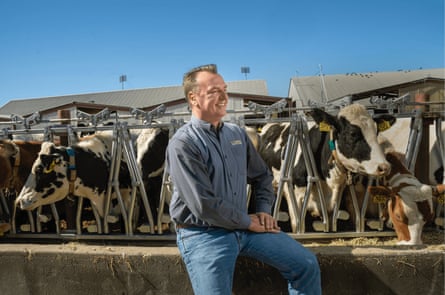
There’s nothing uncommon about scientists taking cash from industries they research, so long as these ties are correctly disclosed. On this case, although, Mitloehner was held up by media and commerce teams as a impartial scientist with out competing pursuits, when that wasn’t fairly the case.
Responding to questions from the Guardian, Mitloehner stated: “Journalists, organizations and even different teachers use my feedback in ways in which I don’t all the time intend. For higher or worse, I can not management what they are saying or how they are saying it.”
But when the incident disturbed Mitloehner, you wouldn’t realize it. He’d go on to coordinate much more actively with huge meat – not simply on analysis, however on messaging.
‘The Schwarzenegger of science communicators’
Mitloehner is a Twitter fixture with a tenacious presence and over 30,000 followers, somebody who weighs in with (usually contrarian) takes on new developments associated to meat manufacturing and local weather. He’s additionally identified for punchy, headline-grabbing weblog posts, in addition to defiant op-eds in mainstream shops – together with the San Francisco Chronicle and the Los Angeles Instances – that defend the sustainability of beef. A glowing profile within the commerce publication Meatingplace known as him “the Schwarzenegger of science communicators” and lovingly dubbed him “the Debunki-nator”.
In 2018, UC Davis introduced it will open a brand new analysis and extension program – the Readability and Management for Environmental Consciousness and Analysis Middle, or Clear Middle – beneath Mitloehner’s path. The middle exists to publish and promote analysis that will increase the effectivity of animal agriculture, particularly beef. What wasn’t evident on the time, however was revealed final 12 months in reporting by The New York Instances, was that the middle was established with a $2.9m grant from IFeeder, the non-profit arm of a livestock {industry} group representing multinational beef packers and different animal agriculture pursuits. The middle has additionally taken a whole bunch of 1000’s of {dollars} in funding from different {industry} sources, in line with the Instances’s report.
In his response to the piece, Mitloehner rightly identified that it’s regular for researchers to take {industry} funding. However the Instances story additionally revealed a extra uncommon dynamic: that the Clear Middle has coordinated public messaging campaigns with {industry} teams.
That appears to have been the objective. In a confidential 2018 memo first obtained by the environmental advocacy non-profit Greenpeace and subsequently printed in full on its web site, IFeeder president Joel Newman outlined a imaginative and prescient for the middle that was largely centered on Mitloehner’s worth as a meat {industry} messenger.
“The communications sub-committee has been working with Dr Mitloehner on increasing his proactive communications, outreach and recognition on key points,” Newman wrote, including that “a number of committee members have forwarded content material for Dr Mitloehner to remark/reply to in addition to folks for him to comply with/have interaction with on Twitter”.
Based on the memo, the overt – if not main – focus of the middle can be to assist messages that downplay meat manufacturing’s environmental toll.
“The Middle’s instant focus is on reviewing present analysis, filling analysis gaps and offering impactful messaging to deal with the numerous misinformation relating to the environmental influence of poultry and livestock manufacturing,” Newman wrote.
As we speak, that imaginative and prescient has come to fruition: supplies generated by the Clear Middle, or that includes Mitloehner, feed the meat foyer’s sprawling counter-messaging machine.
Behind the scenes, Masters of Beef Advocacy graduates coach one another on how greatest to deploy Mitloehner’s analysis and weblog posts of their activism efforts, in line with my evaluation of conversations of their personal Fb group, whereas industry-aligned web sites characteristic him and his work prominently.
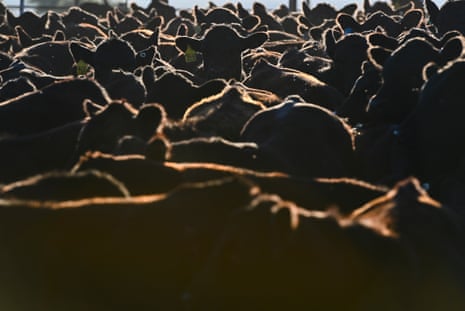
Mitloehner stated in his electronic mail to the Guardian: “The first objective of the CLEAR Middle is to advance sustainability in animal agriculture. We try this with analysis and science communications. As an educational, I observed that analysis that was essential to advancing necessary conversations wasn’t all the time successfully communicated, so the concept was born to create a middle that ensures analysis can be shared.”
He added that his public statements have been rooted in analysis and the aim of the Clear Middle was to “advance sustainability in animal agriculture … with analysis and science communications”. He stated this “can’t be performed with out participating the {industry}” and that by concentrating on methane it was doable for livestock {industry} to achieve local weather neutrality “and eat into historic emissions”.
However different teachers interviewed for this text felt that Mitloehner’s messaging efforts and the style through which they’re routinely amplified by {industry}, transcend the bounds of regular scholarly conduct.
“Frank Mitloehner doesn’t echo {industry} speaking factors; he appears to create whole messaging methods. These messages are then echoed by commerce teams a number of years afterward. He’s then recommended by {industry}, together with his funders, for broadcasting these messages throughout social media and to political teams,” stated Matthew Hayek, an assistant professor at New York College who research agriculture’s greenhouse fuel emissions impacts.
“Solely a fraction of the Clear Middle’s work appears centered on methane discount,” Hayek stated. “Extra broadly, the Clear Middle creates industry-friendly messages to assist battle off a variety of proposals to sort out local weather change. These proposals embrace meat discount, investments in different proteins and producer buyouts away from animal agriculture. His/their positions diverge from local weather skilled consensus and cherry decide scientific findings to undermine how drastic these proposals’ mitigation potential truly is or may very well be.”
A digital command middle staffed 24×7
A five-year technique doc written in 2020 by a handful of main cattle {industry} organizations recognized a necessity to show up the warmth in its messaging battle. Their highest precedence was to “reveal beef’s constructive sustainability message and key position in regenerative agriculture”.
“It’s extremely possible the meat {industry} will proceed to be threatened by laws and/or rules aimed toward curbing greenhouse fuel emissions,” the doc stated. It went on: “The duty pressure believes it’s extra necessary than ever to aggressively promote the a number of benefits of beef and educate customers on how beef suits right into a wholesome life-style and sustainable eating regimen.”
The meat {industry} has lengthy used lobbying and advertising to enhance the enterprise local weather for its merchandise. In a paper she co-authored in 2021, Jacquet described the scope of those efforts, together with intensive lobbying of presidency officers, hundreds of thousands of {dollars} of marketing campaign contributions and public (usually deceptive) net-zero commitments. Then there’s the advertising.
The Cattlemen’s Beef Board – which contracts with the Nationwide Cattlemen’s Beef Affiliation (NCBA) for its advertising and promotion efforts – has lengthy had vital cultural influence. Its well-known early Nineteen Nineties “Beef: it’s what’s for dinner” spots, backed by music from Aaron Copland’s Rodeo suite, are among the many most iconic TV commercials of all time.
Since no less than 2018, NCBA has additionally employed top-shelf artistic companies and public relations companies – together with Ketchum, VML&R and Linhart PR, all of whom even have fossil gas {industry} purchasers – to assist devise its messaging and technique. And whereas its advertising efforts have traditionally shored up assist for beef because the centerpiece of the American plate, these efforts have not too long ago taken on a way more environmental focus. The NCBA-operated web site BeefItsWhatsForDinner.com incorporates quite a few articles and reality sheets downplaying beef’s position within the local weather disaster.
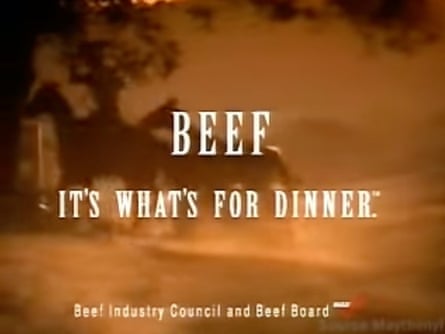
In a non-public video coaching session for beef {industry} influencers, Sarah Reece, NCBA’s senior government director of brand name advertising, described a plan that concerned paid promoting on Google, Fb, Reddit, Youtube and Instagram, in addition to video and audio adverts spots on ESPN, Spotify and Sirius XM Radio. One sustainability-oriented advertising effort, which ran from April to June 2021, generated 60m impressions and drove practically 90,000 clicks to Beef: It’s What’s For Dinner net pages and content material, together with materials muddying the waters about beef’s hyperlinks to local weather. It’s “a encompass sound strategy to achieve customers”, Reese stated. “We’re getting them all over the place they’re.”
These efforts look like going sturdy in 2023. Based on technique paperwork posted to the Beef Board’s web site, NCBA requested $9.1m for content material advertising and paid promoting this 12 months – all of which can serve to enhance beef’s picture, and a few of which can particularly “talk the web local weather and environmental influence of beef manufacturing”.
Then there’s the Masters of Beef Advocacy (MBA) course, although the NCBA has much more formidable plans to fight what it calls “misinformation”.
Utilizing checkoff cash, NCBA has developed what it has known as a “Digital Command Middle” – a complicated on-line monitoring system that tracks media shops and social media for greater than 200 beef-related subjects. Hosted in Denver in an area that “seems like a navy operations middle mixed with the TV part at an electronics retailer”, in line with a current Cattlemen’s Beef Board mailer despatched to ranchers, the Command middle alerts members of NCBA’s points administration and media relations staff at any time when tales or on-line chatter rise above a sure threshold. It’s staffed 24 hours a day, 7 days per week, with personnel redundancies in-built to ensure somebody’s all the time watching.
One objective is to allow the {industry} to reply to rising public well being or financial emergencies. However the middle, which acquired $742,400 in checkoff cash for fiscal 12 months 2023, can also be used to maintain monitor of public conversations round beef’s sustainability in real-time – and to deploy “speaking factors, media statements, reality sheets, infographics, movies and numerous digital property” as essential to shift the phrases of dialog.
NCBA calls it “proactive fame administration”: a technique that entails monitoring the web for messaging alternatives, then leaping in to burnish beef’s picture at any time when it’s advantageous. In 2021, as an illustration, throughout Local weather Week NYC – a time when on-line dialogue of beef’s sustainability tends to skyrocket, in line with NCBA’s monitoring instruments – the group labored to position pro-beef op-eds in information shops, making certain the web chatter would come with its perspective. Within the personal video for MBA college students, Marissa Pooley, NCBA’s senior director of points and fame administration, defined how the NCBA collaborated carefully with chef and rancher contributors to position independent-seeming items in shops like The Denver Publish and Denver alt-weekly Westword.
Local weather Week NYC was “one thing we actually took an enormous swing at and leveraged as a reputational alternative”, Pooley informed college students. She stated content material associated to the op-eds generated hundreds of thousands of views.
It was the identical playbook NCBA had utilized in Could 2021. That spring, two high-profile culinary establishments dropped meat to protest livestock’s outsized position within the local weather disaster: meals media outlet Epicurious determined to cease that includes new recipes with beef, and Manhattan restaurant Eleven Madison Park took meat off its menu completely. The information made headlines. And when NCBA famous the development in its monitoring software, it sprang into motion.
NCBA began by defending beef’s sustainability in a slate of paid advert buys – which ran in shops just like the New York Instances and the Washington Publish – nevertheless it didn’t cease there. Within the personal video for Masters of Beef Advocacy college students, Pooley described how NCBA labored with movie star chef Lamar Moore to write down a bit insisting on a central place for beef on the plate. That story – which ran with the subhead “Why reducing meat from the menu (or journal) is misguided,” ran in LA Weekly – and was plugged repeatedly on Twitter by NCBA (and different {industry} accounts) as if it had no connection to the story.
In reality, not one of the items NCBA privately admits it performed a job in – in LA Weekly, Westword and The Denver Publish – disclosed the commerce group’s participation.
The {industry} sees these messaging efforts as a part of an existential battle for survival. Within the coaching video, NCBA leaders cited knowledge that discovered 47% of Individuals aren’t certain in regards to the sustainability of beef. That persuadable center is a prime precedence for the {industry}, they stated, as whoever reaches them greatest has the facility to sway the stability of public opinion.
The {industry} should have interaction in a “defensive technique”, Pooley informed MBA college students. Sustainability, she stated, “has the potential to grow to be a disaster if we don’t deal with it early”.
Trending
-
Bank and Cryptocurrency11 months ago
Cheap Car Insurance Rates Guide to Understanding Your Options, Laws, and Discounts
-
Bank and Cryptocurrency11 months ago
Why Do We Need an Insurance for Our Vehicle?
-

 entertainement5 months ago
entertainement5 months agoHOUSE OF FUN DAILY GIFTS
-
WORD NEWS12 months ago
Swan wrangling and ‘steamy trysts’: the weird lives and jobs of the king’s entourage | Monarchy
